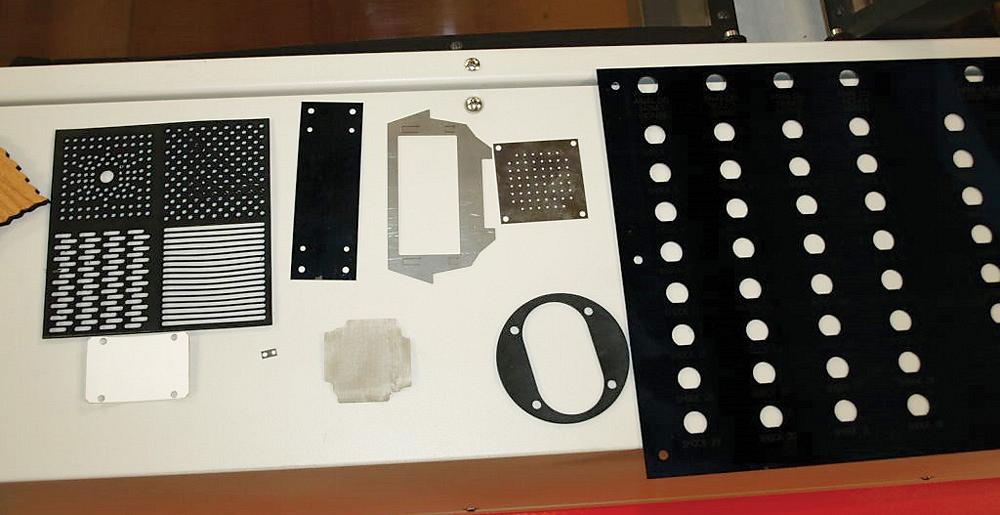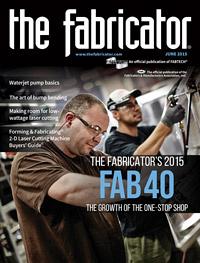Editor-in-Chief
- FMA
- The Fabricator
- FABTECH
- Canadian Metalworking
Categories
- Additive Manufacturing
- Aluminum Welding
- Arc Welding
- Assembly and Joining
- Automation and Robotics
- Bending and Forming
- Consumables
- Cutting and Weld Prep
- Electric Vehicles
- En Español
- Finishing
- Hydroforming
- Laser Cutting
- Laser Welding
- Machining
- Manufacturing Software
- Materials Handling
- Metals/Materials
- Oxyfuel Cutting
- Plasma Cutting
- Power Tools
- Punching and Other Holemaking
- Roll Forming
- Safety
- Sawing
- Shearing
- Shop Management
- Testing and Measuring
- Tube and Pipe Fabrication
- Tube and Pipe Production
- Waterjet Cutting
Industry Directory
Webcasts
Podcasts
FAB 40
Advertise
Subscribe
Account Login
Search
Adding to the arsenal of metal cutting technologies
Advanced Laser & Waterjet Cutting looks to a medium-power laser to round out its capabilities
- By Dan Davis
- June 2, 2015
- Article
- Laser Cutting

Figure 1
Lester Gragg, president, Advanced Laser & Waterjet Cutting
Inc., purchased a 400-W laser machining center to
engrave metal and nonmetal material. He liked the machine’s
performance and flexibility so much that he purchased
a 1-kW version of the same machine in 2014.
Considering his background, it’s not surprising that Lester Gragg finds himself where he is—founder and president of Advanced Laser & Waterjet Cutting Inc., Santa, Clara, Calif. He knows manufacturing and lasers.
His dad was a machinist, and like so many other manufacturing fathers, his dad had no issue with showing his son what a day in the life of a shop worker was like.
“If you were old enough to reach a handle, you could work with a lathe,” Gragg said.
As a young man, Gragg joined the U.S. Air Force (USAF), where he got his first taste of lasers. These lasers weren’t designed for production of metal parts; instead they were in USAF research labs, where work was being done on weapon systems.
After nine years of working with lasers in the USAF, Gragg joined the private sector. He became a laser cutting machine operator for a California metal fabricator. That’s where he got his first taste of the impact that laser technology could make on metal manufacturing.
In 1994 Gragg opened his job shop. Offering laser cutting for other local machine shops and fabrication shops requiring laser-cut parts was a solid foundation to grow the business. He later added a waterjet cutting system to cut materials such as rubber and foam and thick material, sometimes up to 6 inches.
Today Gragg runs a 15-person shop with annual sales revenues of $2.6 million. The shop has a 4-kW CO2 laser cutting machine with a 60- by 120-in. cutting area and two waterjets capable of delivering 60,000 PSI and with cutting areas of 72 by 144 in.
The shop doesn’t offer any machining or forming services because it doesn’t want to compete with many of its customers, shops that offer those services.
Expanding the Cutting Options
Three years ago, Gragg said he started looking for a way to offer laser-engraving services. He sensed a market existed for that, and it would be a natural extension of the cutting his shop was already doing.
But when he started looking, he didn’t like what he saw. The machines had small footprints, and they weren’t set up for production of any kind should they be needed to supplement typical orders that flowed through the shop. Most of the machinery offerings were not set up for job shops.
The Coherent MetaBeam laser machining center (see Figure 1), on the other hand, met some of Gragg’s criteria. The 400-W CO2 laser was capable of engraving (see Figure 2) as well as larger production jobs (see Figure 3) on its 48- by 48-in. cutting table.

Figure 2
With the 400- and 1,000-W laser cutting machines’ ability
to generate high levels of acceleration during operation,
they can produce elaborate engraving, such as this work
on wood, in minutes.
Gragg purchased the machine and immediately found work for it. The laser cut nonmetals, such as synthetic rubber gaskets, acrylic, wood, fabric, and other “organic material”—as the Coherent officials call them—up to 1.25 in. As for metals, the table cuts and etches mild steel, aluminum, stainless steel, and even titanium parts. It can cut up to 0.125-in.- thick mild steel.
Capacity Issues at Play
In mid-2014, Advanced Laser & Waterjet Cutting was at a crossroads. Business was robust enough to warrant investing in another laser cutting machine, but Gragg didn’t need another 4-kW CO2 machine.
“We just didn’t need that much power,” he said.
Gragg liked several features of his 400-W MetaBeam machine that made him think it might make sense to repeat the purchase:
- Productivity. Materials can be loaded quickly onto the machine. Material thickness is quickly determined by a capacitive sensor that accurately maintains the correct standoff distance from the workpiece. When cutting begins, the lightweight optics head quickly accelerates, speeding up cutting jobs.
- Energy Efficiency. A sealed slab discharge CO2 laser works more efficiently than a traditional CO2 laser resonator. No pumps, blowers, and heat exchangers are needed to circulate and cool the gas. The gas is sealed in the MetaBeam laser and should remain in pristine shape for 40,000 operational hours, according to Coherent. (For more details, see the How the Laser Works sidebar.) This configuration reportedly offers nearly 50 percent greater efficiency than traditional CO2 laser technology, which translates into savings in electricity costs. Also, the sealed slab discharge laser requires no warm-up period before it is able to deliver a laser.
- Ease of Use. Job files are easier to create when compared to the larger 4-kW system, which requires very clean DXF files in which the lines, arcs, and circles have to be distinct to be picked up and converted into machine code. The MetaBeam system software isn’t so finicky. In fact, shop personnel regularly throw simple Adobe Illustrator or CorelDraw files into the system and have no issues with cutting patterns being generated quickly and correctly. The software also makes tasks such as scribing, engraving, and kiss cutting easy.
In the end, familiarity with an effective machine tool helped to tip the purchase decision. Advanced Laser & Waterjet Cutting just needed more power than 400 W.
Going Bigger
Gragg placed an order for the META 10C 1-kW CO2 laser cutting machine and had it installed before the end of 2014. It has emerged as the machine tool of choice for quick cutting jobs of material that are under 0.125 in. thick.
“Why not throw a part on something that could cut it quickly and precisely,” Gragg said.
Shop personnel can throw material on the 4- by 4-foot table and a vacuum holds the material in place on the table. The lightweight cutting head, which can hit speeds up to 2,000 IPM, according to Coherent, quickly gets to work.
“For jobs that involve more than just a few simple cuts, the processing time is actually much lower than we can achieve with our 4-kW laser machine,” Gragg said.
For someone that has spent his career around lasers, does Gragg wonder if he missed out by not purchasing the latest fiber laser equipment?

Figure 3
The shop has found its lower-power lasers to be a suitable alternative for laser cutting parts when the 4-kW laser cutting machine is occupied.
He doesn’t think so. The 400- and 1,000-W laser cutting machines can deliver almost the same kerf width as a fiber, and the 4-kW machine can handle a broad range of material thicknesses. Gragg estimated that less than 1 percent of the jobs his shop quotes would benefit from processing with a fiber laser.
How the Laser Works
The sealed slab discharge laser resonator has two rectangular plate electrodes with a narrow gap between them. When energized by RF excitation, the plasma fills the entire rectangular space between the electrodes. Laser light is produced, and cylindrical mirrors at each end reflect the light, allowing it to gain energy over virtually the entire plasma volume.
One of the side mirrors has a gap that allows some of the intracavity power to feed out of the resonator. Mirrors are used to direct the laser to the cutting head.
The electrodes are water-cooled. Because of the electrodes’ large surface area and close spacing, the water can cool the plasma effectively without any need for gas circulation, even at high duty cycles. In traditional CO2 laser resonator designs, high-speed pumps are needed to boost the flow of a laser gas mixture through a plasma discharge tube; the rapid flow of the gas enables the gas to stay cool and contributes to the optimal optical power.
This sealed slab discharge laser was originally designed for precision cutting of materials such as plastics, fabrics, wood, and thin metals. Cut quality, surface finish, and precision—with 100- to 500-W units—were valued over production cutting speed. The emergence of 1,000-W machines has expanded the use of these types of lasers in production settings.
About the Author

Dan Davis
2135 Point Blvd.
Elgin, IL 60123
815-227-8281
Dan Davis is editor-in-chief of The Fabricator, the industry's most widely circulated metal fabricating magazine, and its sister publications, The Tube & Pipe Journal and The Welder. He has been with the publications since April 2002.
Related Companies
subscribe now

The Fabricator is North America's leading magazine for the metal forming and fabricating industry. The magazine delivers the news, technical articles, and case histories that enable fabricators to do their jobs more efficiently. The Fabricator has served the industry since 1970.
start your free subscription- Stay connected from anywhere

Easily access valuable industry resources now with full access to the digital edition of The Fabricator.

Easily access valuable industry resources now with full access to the digital edition of The Welder.

Easily access valuable industry resources now with full access to the digital edition of The Tube and Pipe Journal.
- Podcasting
- Podcast:
- The Fabricator Podcast
- Published:
- 04/16/2024
- Running Time:
- 63:29
In this episode of The Fabricator Podcast, Caleb Chamberlain, co-founder and CEO of OSH Cut, discusses his company’s...
- Trending Articles
AI, machine learning, and the future of metal fabrication

Employee ownership: The best way to ensure engagement

Steel industry reacts to Nucor’s new weekly published HRC price

Dynamic Metal blossoms with each passing year

Metal fabrication management: A guide for new supervisors

- Industry Events
16th Annual Safety Conference
- April 30 - May 1, 2024
- Elgin,
Pipe and Tube Conference
- May 21 - 22, 2024
- Omaha, NE
World-Class Roll Forming Workshop
- June 5 - 6, 2024
- Louisville, KY
Advanced Laser Application Workshop
- June 25 - 27, 2024
- Novi, MI



























